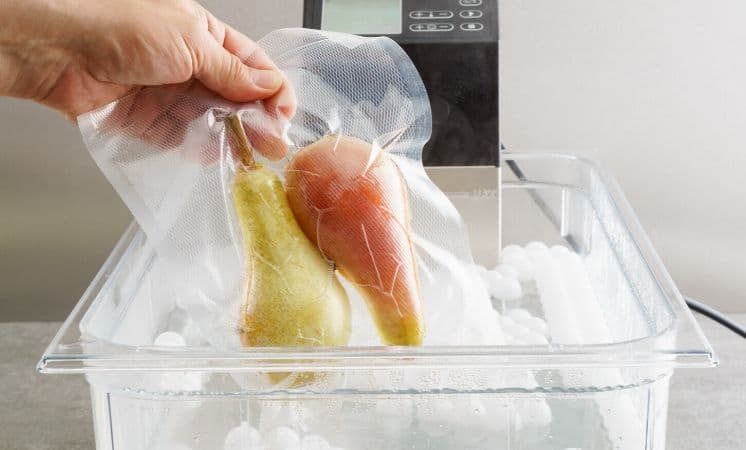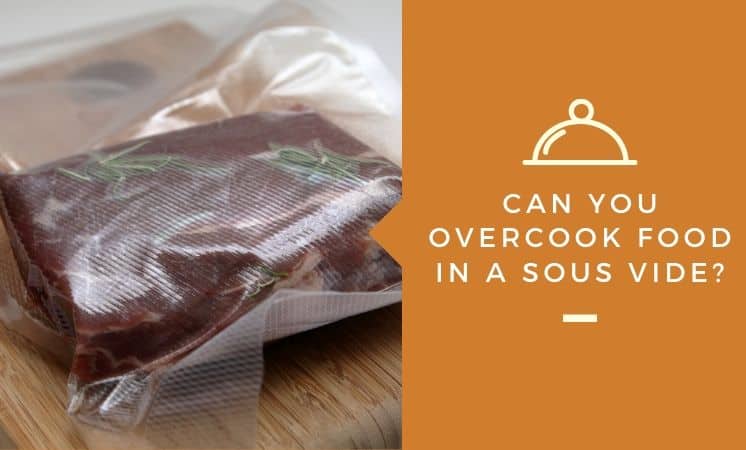One of the trickiest aspects of cooking food at home is striking the perfect balance between temperature and precise timing so that the result is a dish that is neither undercooked nor overcooked and is flavorful in taste.
For those who do not have as much time to prepare home-cooked meals at night due to the cooking process taking up a considerable amount of time and effort, often end up eating overcooked dishes, burnt dishes, or bland dishes.
To combat this, many individuals are turning towards a specific countertop appliance that is said to make overcooking your food nearly impossible; the sous vide machine. The term, sous vide (French), refers to “under vacuum” as the food is sealed in a vacuum-sealed bag and placed in an airtight container underwater.
We have looked at sous vide cooking and asked, is it possible to overcook your food in a sous vide circulator?
The answer is, no, it is not possible to overcook your food in a sous vide machine. The machine uses a heated metal coil to warm up the water at a consistent temperature, ensuring that the entire cooking process is controlled and gradual. This means that your food will never be overcooked as the temperature you are cooking at is the intended temperature of the final product.
Your food will never go beyond this temperature and therefore, never be overcooked. However, if you leave your food in the water bath for an extended period of time, it can come out with a mushy texture.
To help you avoid this mushy texture, read on to find out how long you can leave your food in the sous vide and cooking mistakes that can cost you that perfect meal.
How Long Can You Leave Food in a Sous Vide?
With the sous vide method, you can hold your food at the desired cooking temperature for longer periods of time than you can with traditional cooking techniques.
However, there is generally a maximum amount of time that you do not want to surpass as doing so will risk the breakdown of your food. When the fibers of your food breakdown, you get that mushy and “overcooked” texture.
For the best results, do not leave your food for more than 72 hours. For a quick reference of how long to leave your food in sous vide, please refer to the numbers below.
- Prime Rib Roast, Ribeye Roast, Sirloin Roast, Tri-Tip Roast: 5-10 hours.
- Stew Meat: 4-8 hours.
- Blade Steak, Flat Iron Steak: 4-10 hours.
- Sirloin Steak, Tri-Tip Steak: 2-10 hours.
- Chicken thighs or breasts: 3-12 hours. However, they are often best at the 2-4-hour mark.
- Pork Chops: 3-12 hours. However, they are often best at the 3-6-hour mark.
- Shredded Chicken: 8-12 hours.
- Pork Back Ribs, Shank: 8-10 hours.
- Country-style ribs: 8-12 hours.
- Ham Roast: 10-20 hours.
If you are looking for foods that cook faster than the above noted times, then look at making fish, eggs, and thin cuts of beef, chicken, and pork.
Fish will cook in 30-60 minutes, 1.5” beef tenderloin/steak/ribeye can cook in under 2 hours, and thin pork chops/loin can also be sous vide in under 2 hours. A lot of vegetables will take 1-2 hours.
The amount of cooking time needed will increase exponentially in relation to how thick the food is. For instance, a 4” steak will need to cook at a rate of 3 times more than a 2” steak.
Is It Safe to Sous Vide Overnight?
It is completely safe to cook your food with the sous vide method overnight and some cuts of protein will even require it.
For instance, if you are cooking multi-day meats such as chuck roast, pulled pork, ribs, and regular pot roast, these will take anywhere from 24 hours to 3 days in time.
For a quick reference of how long to leave your food in sous vide, please refer to the numbers below.
- Lamb Arm, Blade Chop, Leg (boneless): 18-36 hours.
- Lamb Breast: 22-26 hours.
- Pulled Pork, Pork Butt/Shoulder: 1-2 days.
- Pork Belly: 2-3 days.
- Lamb Bone In: 1-2 days.
- Top Round Steak: 1-2 days.
- Bottom Round Steak: 2-3 days.
- Brisket: 2-3 days.
- Flank steak: 1-2 days.
- Beef Ribs, Short Ribs: 2-3days.
Can Sous Vide Be Left Unattended?

Yes, you can leave your sous vide machine unattended and walk away from it while it cooks your food.
The only thing that should be kept in mind is that if you are not clipping your vacuum-sealed bag to the side of the sous vide, then you may run into difficulties if you are not at home to catch the bag being sucked towards the circulator device.
Always clip your bag to the side to prevent obstruction of water flow.
What Kinds of Foods Can Be Cooked With Sous Vide?
Any delicate cut of meat or tougher cuts of meats can be cooked in sous vide. This includes pork, lamb, beef, chicken/poultry, and fish. You can also cook seafood, root vegetables, potatoes, and even eggs.
Fruits, such as apples, pears, and peaches can also be cooked in sous vide but should be paired with a flavor infusion.
It is recommended that you do not try to cook green vegetables in sous vide, such as broccoli or green beans as these will lose their vibrant color and taste due to the longer cooking times.
You can even make some custard-style creams and sauces without the worry of them curdling.
These types of creams and sauces can be held at serving temperature, which makes them a breeze to serve right from the water bath itself to your guests come mealtime.
What About Cooking Foods with Seasonings? How Does That Work?
Since the food is being packaged and cooked within its own natural juices and flavors, you do not need as much seasoning as you would with other cooking methods.
If you plan on using a lot of herbs, try using 30% less than what you normally use and experiment to get the right strength. Make sure that you distribute any seasoning equally throughout the bag or across the food, as you don’t want some parts being over-seasoned.
If you like cooking with garlic for items like steak, chicken, or fish, please note that it does not cook at sous vide temperatures and will, therefore, be overpowering in flavor. Instead, if you want garlic, sauté or roast it first before introducing it to the bag.
As for alcohol-based liquids, pre-cook it. In the sous vide, the alcohol cannot evaporate which will cause a harsh and unpleasant flavor.
Is It Safe to Sous Vide-Cook My Food at Low Temperatures?
Cooking at low temperatures puts your food in what people call the “danger zone” which is a range of temperatures in which food-borne bacteria can grow on your food and make you seriously ill if you eat it.
However, cooking at low temperatures for longer periods of time is safe, as food can be pasteurized and kill off any bacteria growth.
In so long as you are cooking between the temperatures of 130-195 degrees Fahrenheit and allowing the food to cook for longer than 20-30 minutes, you are safe.
Common Mistakes to Avoid When Cooking in Sous Vide
- Do not mishandle fat. When you are cooking in sous vide, you are cooking at a temperature that is rather low. The fat on your meat will take a long time to render at low temperatures and will thus, come out rubbery which is unappetizing. To eliminate this problem, either pre-sear your meat before placing it in the water bath, trim off the fat or choose a leaner cut, or cook your meat for longer if you are cooking a piece that has marbled fat throughout it.
- Handle Your Pouches Correctly! Always use high-quality pouches for your sous vide, as any type of tearing in the pouch can lead to water getting into the bag and making a mess out of your food. Do not use tongs when pulling your pouches out of the water bath as these can puncture the bag or completely mash up your food. Always weigh down your pouches with a clip to prevent them from floating.
- Do Not Let the Water Evaporate. If you walk away from your sous vide machine without covering your container with plastic wrap, the water can evaporate and potentially ruin your machine and your food. Always follow the manufacturer’s instructions on how to wrap your sous vide machine so that the water does not escape while it is left unattended.
While you cannot overcook your food in the traditional sense of the word, leaving your food for too long, especially if it is a thinner cut, can make it come out mushy or rubbery.
So, make sure that you are using thicker cuts of food if you are planning on leaving it in for a long period of time and read and practice the recipes. Always follow the directions carefully, as every sous vide machine is unique.

